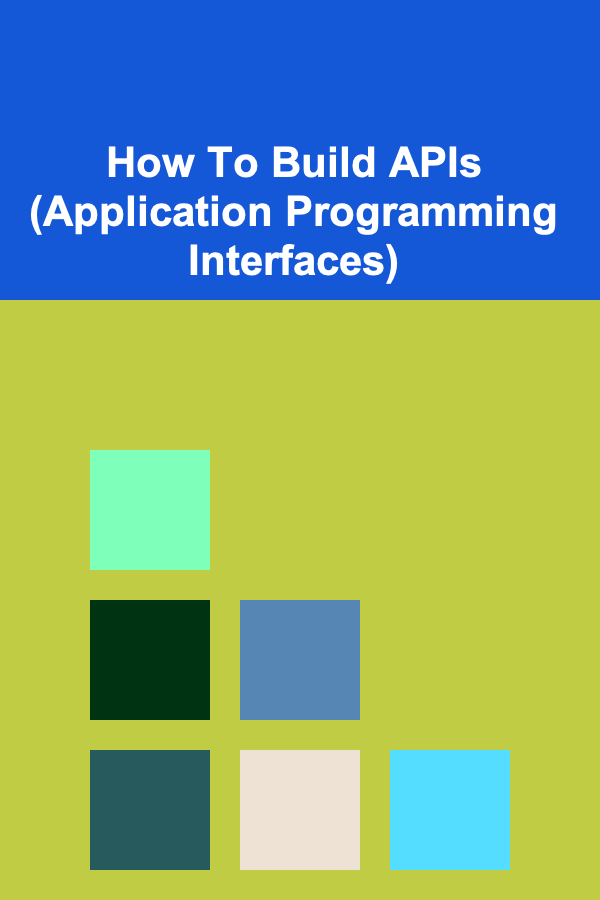
How To Build APIs (Application Programming Interfaces)
ebook include PDF & Audio bundle (Micro Guide)
$12.99$8.99
Limited Time Offer! Order within the next:

Building Application Programming Interfaces (APIs) has become an essential skill for software developers. APIs allow different software systems to communicate with one another and exchange data. Whether you're building a mobile app, a web application, or an integration service, understanding how to create APIs that are efficient, secure, and easy to use is vital for a successful development process.
This guide will provide you with a comprehensive, step-by-step approach on how to build APIs, covering everything from understanding what APIs are, to the key concepts involved, and finally to practical implementation.
What is an API?
An API (Application Programming Interface) is a set of rules, protocols, and tools for building software and applications. It defines how different software components should interact. APIs are used to allow different applications to communicate with each other, facilitating tasks like data retrieval, sending information, or calling a specific function in an external system.
There are various types of APIs, but the most commonly used ones are:
- Web APIs: Enable communication between systems over the internet (HTTP-based protocols).
- Library APIs: Allow interaction with libraries in a programming language.
- Operating System APIs: Provide access to low-level functions in an operating system.
APIs can be public, private, or hybrid, depending on the needs of the organization. Public APIs are open to developers and external users, whereas private APIs are intended for internal use.
Why Build APIs?
The role of APIs in modern software development cannot be overstated. Here are several reasons why you might want to build an API:
- Data Sharing and Integration: APIs enable different systems to share data and integrate with each other seamlessly. For example, integrating a payment gateway (such as PayPal or Stripe) into your application often requires using an API.
- Simplified Development: APIs abstract complexity, allowing developers to focus on higher-level application functionality rather than managing underlying system operations.
- Microservices Architecture: APIs are crucial in microservices architecture, where different services communicate through APIs, making the system scalable and more maintainable.
- Extensibility: APIs can allow external developers to extend the functionality of your application, fostering innovation and new use cases.
Key Concepts in API Development
Before diving into how to actually build an API, it's essential to understand several key concepts that will help guide your development process.
3.1. HTTP Methods
HTTP methods define the action to be performed on a resource (data) via the API. The most common HTTP methods are:
- GET: Retrieve data from the server.
- POST: Send data to the server to create a new resource.
- PUT: Update an existing resource on the server.
- DELETE: Remove a resource from the server.
3.2. Endpoints
An API endpoint is a URL where a particular resource or service can be accessed. For example, if you're building an API for a blogging platform, the endpoint for retrieving a post might look like this: https://api.example.com/posts/{id}.
3.3. Request and Response Formats
APIs communicate through requests and responses. A client sends a request to an API, and the API sends back a response.
- Request: Contains information about what the client wants to do (such as parameters, authentication credentials, etc.).
- Response: Contains the data the client requested, or an error message if something went wrong.
Most modern APIs use JSON (JavaScript Object Notation) as the standard format for sending and receiving data.
3.4. Status Codes
When making an API request, the server responds with a status code that indicates whether the request was successful or not. Some common HTTP status codes include:
- 200 OK: The request was successful.
- 201 Created: A new resource was created successfully.
- 400 Bad Request: The server cannot process the request due to malformed syntax.
- 401 Unauthorized: The request requires user authentication.
- 404 Not Found: The requested resource could not be found.
- 500 Internal Server Error: The server encountered an error processing the request.
3.5. Authentication and Authorization
Many APIs require users to authenticate before they can access the data. Common methods of authentication include:
- API Keys: A unique key assigned to users to authenticate their requests.
- OAuth: A more secure and flexible method for authorization, often used for third-party integrations (e.g., logging in with Google or Facebook).
Steps to Build an API
4.1. Plan Your API
Before you start coding, it's crucial to plan your API. This step ensures that your API is well-structured and meets the needs of the users. Here are some questions to consider during the planning phase:
- What is the purpose of the API? Are you sharing data between systems, enabling users to interact with a service, or building a third-party integration?
- Who will be using the API? Will it be public or restricted to certain users?
- What resources will the API expose? Resources could include user data, products, orders, etc.
- What endpoints will you need? Plan the various endpoints and HTTP methods you will need to support.
- What kind of data will the API handle? Will it return JSON, XML, or other formats?
4.2. Design the API
The next step is to design your API. Good design makes it easier for developers to interact with your API. Here are some design tips:
- RESTful Design: REST (Representational State Transfer) is a common architectural style used for web APIs. A RESTful API focuses on resources, uses standard HTTP methods, and is stateless (each request is independent).
- Naming Conventions : Use consistent, meaningful naming for your endpoints. For example, to retrieve a list of users, use
GET /users. For retrieving a specific user, useGET /users/{id}. - Versioning : APIs can change over time, so it's important to version your API. A common approach is to include the version in the URL, such as
https://api.example.com/v1/.
4.3. Build the API
Now that you have your plan and design in place, it's time to start building the API. You can use various programming languages and frameworks to build an API, depending on your preferences and requirements.
Example: Building a Simple API with Flask (Python)
app = Flask(__name__)
@app.route('/api/posts', methods=['GET'])
def get_posts():
posts = [
{'id': 1, 'title': 'First Post', 'content': 'This is the first post.'},
{'id': 2, 'title': 'Second Post', 'content': 'This is the second post.'}
]
return jsonify(posts)
if __name__ == '__main__':
app.run(debug=True)
In this example, we're using Flask, a micro-framework for Python, to build a simple API that returns a list of posts in JSON format when the GET /api/posts endpoint is accessed.
Example: Building a Simple API with Express (Node.js)
const app = express();
app.get('/api/posts', (req, res) => {
const posts = [
{ id: 1, title: 'First Post', content: 'This is the first post.' },
{ id: 2, title: 'Second Post', content: 'This is the second post.' }
];
res.json(posts);
});
app.listen(3000, () => {
console.log('API is running on http://localhost:3000');
});
Here, we are using Express, a minimal web application framework for Node.js, to build the same API as the Flask example.
4.4. Test the API
Once your API is built, you should test it to ensure that it behaves as expected. Some ways to test your API include:
- Unit Testing: Writing automated tests to check each component of your API.
- Postman: A popular tool for testing APIs manually by sending different types of requests and checking the responses.
- Swagger/OpenAPI: A tool for documenting and testing APIs interactively.
4.5. Document the API
API documentation is essential for making your API usable by others. The documentation should explain how to use the API, what endpoints are available, the expected request and response formats, authentication methods, and error handling.
There are several tools available to help you document your API, including:
- Swagger/OpenAPI: A popular specification for documenting APIs.
- Redoc: A tool for generating beautiful API documentation from OpenAPI definitions.
4.6. Secure the API
Security is a critical aspect of building APIs. Some common strategies for securing an API include:
- HTTPS: Always use HTTPS (secure HTTP) to encrypt data in transit.
- Authentication: Use authentication methods like API keys, OAuth, or JWT (JSON Web Tokens) to verify the identity of users.
- Rate Limiting: Prevent abuse of your API by limiting the number of requests a user can make within a certain time frame.
- Input Validation: Ensure that all input is validated to prevent injection attacks and other vulnerabilities.
4.7. Deploy the API
Once your API is built and tested, it's time to deploy it to a server so others can access it. You can deploy your API to a variety of platforms, such as:
- Heroku: A platform as a service (PaaS) that makes deploying applications easy.
- AWS Lambda: A serverless computing service that can run your API without provisioning servers.
- DigitalOcean: A cloud infrastructure provider for deploying and managing applications.
4.8. Maintain and Monitor the API
After deployment, it's important to monitor your API to ensure it's functioning correctly. Use monitoring tools like New Relic, Datadog, or custom logging solutions to track API performance, errors, and usage.
Additionally, you will need to update and maintain your API over time, which might involve adding new features, fixing bugs, and improving performance.
Conclusion
Building an API is a valuable skill that can open up new possibilities for software applications. By planning carefully, designing effectively, implementing securely, and documenting thoroughly, you can create APIs that provide lasting value to users and other developers. As the demand for API-driven integrations continues to grow, mastering the art of API development is an essential step in your journey as a software developer.
Reading More From Our Other Websites
- [Weaving Tip 101] Threading Success: How Modern Weaving Techniques Can Transform Your Business Operations
- [Scrapbooking Tip 101] How to Blend Mixed Media Paint Techniques with Traditional Scrapbooking
- [Personal Investment 101] Turn Deep Learning into a Sustainable Source of Passive Income
- [Home Rental Property 101] How to Choose the Right Location for Your Rental Property
- [Personal Care Tips 101] How to Eat Out and Stay on Your Diet
- [Toy Making Tip 101] Volunteer Spotlight: How Community Toy Workshops Are Changing Lives
- [Toy Making Tip 101] Sustainable Play: How to Turn Plastic Bottles and Cardboard into Fun Educational Toys
- [Scrapbooking Tip 101] Seasonal Inspirations: The Best Scrapbooking Paper Pads for Holiday Albums
- [Paragliding Tip 101] Understanding the International Paragliding Certification Standards: A Beginner's Guide
- [Home Staging 101] How to Stage a Home with Pets for Buyers

How to Build a Checklist for Holiday Wreath and Garland Placement
Read More
How to Use Lighting to Accent Your Home's Interior Design
Read More
Innovative Supply Chain Solutions: Leveraging Technology for Efficiency
Read More
How to Outline Creative Stories Using ChatGPT
Read More
How to Get Started with Aqua Fitness
Read More
How to Plan a Winter Holiday Checklist: Snow & Ice Safety
Read MoreOther Products

How to Build a Checklist for Holiday Wreath and Garland Placement
Read More
How to Use Lighting to Accent Your Home's Interior Design
Read More
Innovative Supply Chain Solutions: Leveraging Technology for Efficiency
Read More
How to Outline Creative Stories Using ChatGPT
Read More
How to Get Started with Aqua Fitness
Read More